Zeynep Çelik Alexander and John May
University Of Minnesota Press
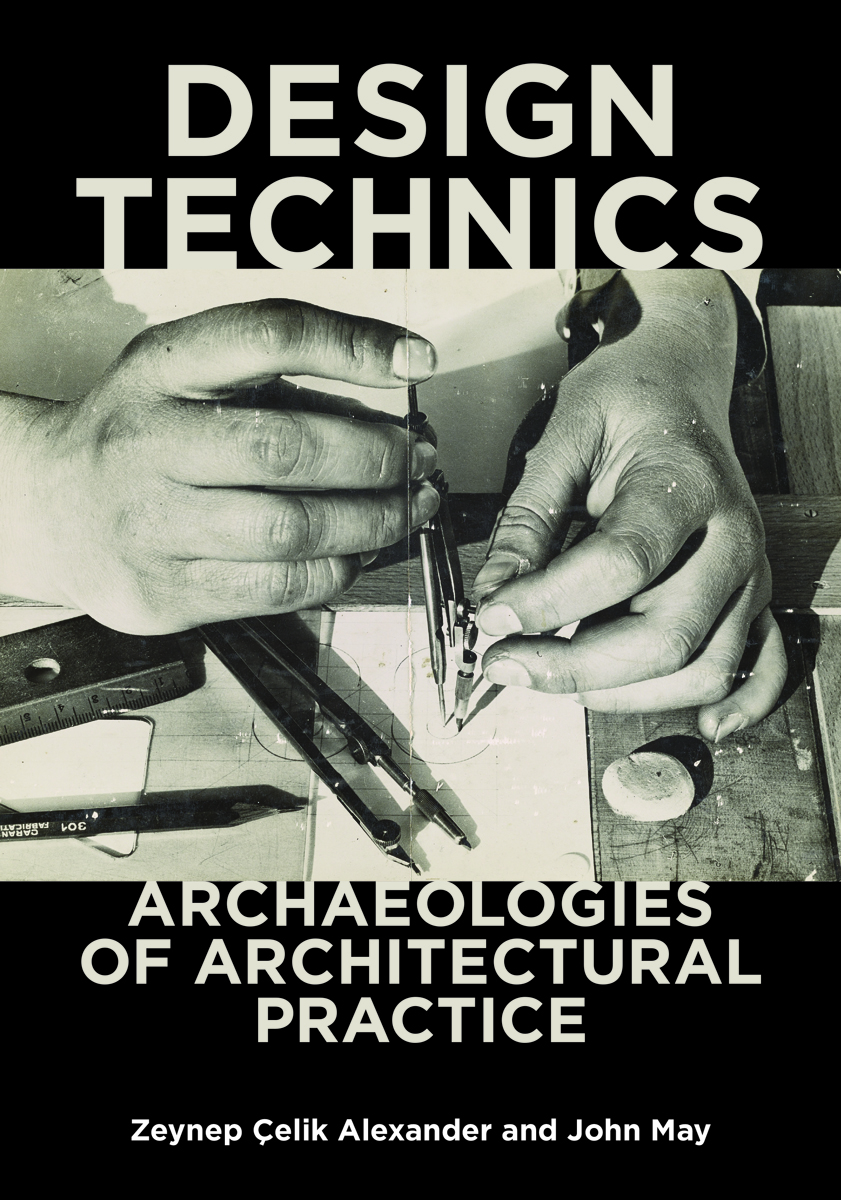
Some two decades ago, Karin Knorr Cetina, Ted Schatzki, and Eike von Savigny produced a collection of essays epitomizing a “practice turn” in social theory.1 Connecting the book’s otherwise heterogeneous chapters was a common “practice approach” that entailed two key moves: shifting the analysis toward embodied and materially embedded practices and the vesting of these practices with transformative power.2 Now architectural history and theory has acquired an explicit announcement of its own practice turn. Zeynep Çelik Alexander and John May’s new edited volume constructs archaeologies of architectural practice by bringing together a group of powerhouse architecture, art, and science historians. The focus here is not on the capital-p “Practice” by which architects often refer to a body of creative work or to the professional identity of its author/s. Rather, the editors redefine architectural practice as a plural field of activities entangled with technics—a key term they use to signify both artifacts and processes.
The ambition of Design Technics extends beyond an overhaul of architectural historiography. The book promises to redirect architectural education by liberating technics from current reductions to skillsets, problem-solving rationalities, or “digital” rhetoric and, crucially, to re-theorize the discipline. In her introduction—a tour de force of methodological clarity and programmatic intention—Çelik Alexander situates the book in the lineage of theorists such as Siegfried Giedion, Reyner Banham, and Lewis Mumford, who challenged the flattening of technics to tectonic symbolism in modern architectural theory. Critical of these theorists’ aestheticization and formal ossification of technical artifacts and systems, Çelik Alexander calls for a refocusing from “artifactual” to “procedural” technics: technics viewed as the entanglement of architectural activities, material arrangements, and larger social, cultural, managerial, and institutional processes.
If architecture is knowledge production, Çelik Alexander suggests, then theory is architecture’s epistemological positioning within knowledge institutions. Technical histories that interweave abstract intellectual ideas with concrete, situated practices bring this positioning more crisply into view. This refreshing proposition offers a way out of the impasses of architectural history/theory, which have been pithily summarized in Mark Jarzombek’s “The School of Architectural Scandals” or targeted by recent scholarly initiatives such as e-flux Architecture’s project “Theory’s Curriculum.”3 Pleading allegiance to “epistemological modesty,” Design Technics advocates for a piecemeal reconstruction of the architectural discipline through theoretical and philosophical reflection on rigorous archival excavations (xviii) . Alluding to the practice approach outlined in Çelik Alexander’s introduction, the book’s seven main chapters are named after gerunds: rendering, modeling, scanning, equipping, specifying, positioning, and repeating.
In her critical archaeology of rendering Lucia Allais reads computer graphics technologies not through the dominant category of interactivity, but instead that of “interpassivity”: the delegation of experience to electronic machines. For it is experience, she argues, both as sensorial impression and entrenched practice, that rendering has historically configured. Through close readings of images and apparatuses spanning from the late 18th century to the present, Allais exposes protocols for calculating relationships between lines and shadows as embodied, subject-forming, and culturally embedded. Most compellingly, I would argue, she ties these protocols to a long-standing endeavor of reconciling expert practices concerned with the mathematization of the visual world with public witnessing and its demands for immediacy and familiarity.
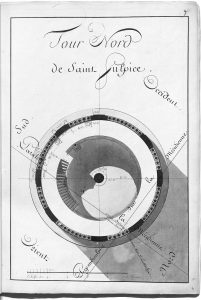
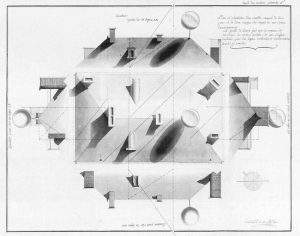
Next comes Matthew Hunter’s positive reclaiming of modeling’s latent theoretical and operative potential. Through 17th- and 18th-century architectural episodes, Hunter historicizes, to then undo, persistent understandings of models as imitative, instrumental, and epistemically inferior to abstract mathematical knowledge. Drawing parallels between Kantian philosophy and current approaches in the analytical philosophy of science, Hunter counterposes an understanding of models as rule-bound, generative processes productively implicated with fiction and world-building—as processes to be followed and believed rather than things to be read and imitated.
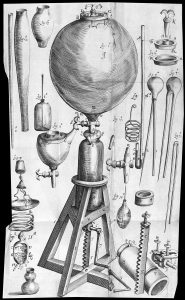
Figure 3. Robert Boyle’s air pump as designed and built by Robert Hooke in collaboration with Ralph Greatorex. Robert Boyle, New Experiments Physico-mechanicall, Touching the Spring of the Air, and Its Effects (1660).
Closely enacting the Introduction’s methodological program, Çelik Alexander’s chapter on scanning juxtaposes two distinct intellectual approaches to form. She extrapolates these approaches from two pre-digital machines for automatically “reading” letters and numbers: one operating by recognizing meaningful wholes and one by statistically processing discrete character fragments. The chapter brilliantly complicates materialist accounts of knowledge production, exposing relationships between intellectual categories and their technical underpinnings as dialectical instead of causal. The investment of humanism in formal unity in Bauhaus and postwar pedagogy, Çelik Alexander shows, was precisely stabilized by concurrent technical processes of discretizing form for purposes of mechanical automation.
Shifting gears from representation to programs of action, Edward Eigen’s essay on equipping is a scrumptious dive into 19th century illusionist Robert-Houdin’s memoirs of his residence at St. Gervais. Eigen describes a parade of automatic contraptions—from tables to doorbells, and from letterboxes to clocks—that readers will be compelled to see as precursors of “intelligent” gadgets variously populating contemporary homes. Through lavish accounts of these contraptions’ workings and their relationships with the humans that they served or replaced, Eigen foregrounds the tension between comfort and control as the key predicament of equipping domestic life with agentive machines that reroute protocols of human domestic work. Michael Osman’s essay on specifying then examines how programs of action are encoded not in automata, but in written building specifications. Through a history of the American balloon frame, Osman discusses how the clerical work of producing such inscriptions enabled architects to control action at a distance, and in doing so, stabilized architectural authorship. Osman shows that it was the specifications’ generality (and not their standard nature) that allowed the balloon frame to proliferate and adapt in contexts that varied in terms of available materials, costing, and craft practices.
John Harwood’s subsequent essay on positioning expands Osman’s contemplation of architecture’s managerial dimensions by taking on logistics, lodging, and transporting as an architectural problem. Alongside histories of logistics and cogent media analyses of “real time,” “delay,” and “redundancy” in architecture, Harwood argues for an urgent recalibration of historians’ attention from architecture’s symbolic function to the ways that it enacts cultural techniques of movement.
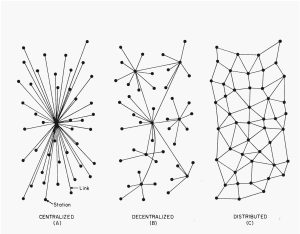
Finally, Orit Halpern’s chapter on repeating genealogically ties values of resilience and adaptability, increasingly projected on the design and management of urban environments, to reconfigurations of memory and temporality in cybernetics research. By modeling the brain as a neural network, she argues, cyberneticians recast rationality as inherently psychotic: unable to differentiate between self-generated and external stimuli. It is precisely this psychotic logic, Halpern suggests, that made nets capable of self-differentiation and dynamic change. Readers familiar with celebrations of cybernetic epistemology’s open-ended and performative dimensions promoted by scholars such as Andrew Pickering, will find a provocative critical alternative in Halpern’s alignment of cybernetic temporality with what Brian Massumi calls preemption —an affective logic of potential.4
We might then read John May’s afterword—a version of his Log essay “Everything is Already an Image” and a précis of his newly published book Signal.Image.Architecture—as a contemplation of precisely the suppression of historical time within technical networks.5 Enabled by the technical regime of “post-orthography” that replaces drawing with the processing of electronic signals, architecture in real time suspends all past political and ethical questions from architectural consciousness. The answer to this predicament, May argues, is not to deny this new regime by clinging on to “pseudo-orthographic” representations, but to critically embrace the ways in which post-orthographic technics generate a new architectural consciousness.
The practice turn orchestrated by Design Technics is overtly post-humanist. Its chapters collectively expose human experience, cognition, perception, labor, and reason as “ontologically codependent” on technical configurations (xviii). And yet, as valuable as such a post-humanist stance may be for overthrowing both authorially and technologically determinist tropes in architecture, it is not free of potential setbacks. A preoccupation with technical mediation risks abstracting bodies within procedural flows and protocols. Such abstraction, in turn, can unwittingly efface those contingencies of architectural practice that stem precisely from human bodies’ gendered, racialized, or other cultural dimensions. As Ruha Benjamin compellingly argues, a post-humanist stance can exclude certain possibilities of discourse, for it assumes “that we have all had a chance to be human.”6 Perhaps the humanist tenets that Çelik Alexander critiques in Giedion’s, Banham’s, and Mumford’s theories of technics can, instead of being rejected, be recast as a methodological commitment to the irreducibility of embodiment. Overall, Design Technics is a landmark book that opens up invigorating horizons for historical and theoretical investigation. More so than producing theories, the book’s seven gerund-titled chapters provide models in the sense that Matthew Hunter promotes: works that allow us to move forward through following the generative constraints by which they have been produced.
Endnotes:
Theodora Vardouli, PhD, is an assistant professor at the Peter Guo-hua Fu School of Architecture, McGill University. Her research examines histories, cultural meanings, and operational implications of algorithmic techniques for describing, generating, and simulating architecture. Vardouli’s articles have been published in Leonardo, Design Studies, Perspective, Nexus, IEEE Annals of the History of Computing and several edited collections. She is co-editor of Computer Architectures: Constructing the Common Ground (Routledge 2020). Her research has been supported by the Canada Foundation for Innovation, the Fonds de recherche du Québec – Société et culture, the Social Sciences and Humanities Research Council of Canada, and the Onassis, Leventis, and Fulbright Foundations.
How to Cite This: Vardouli, Theodora. Review of Design Technics: Archaeologies of Architectural Practice, by Zeynep Çelik Alexander and John May, JAE Online, October 9, 2020.






